📜 World War I: In-Depth Articles on the Great War’s Key Events, Battles & Innovations
📌 Explore detailed articles on World War I, including key battles, military innovations, immigrant soldiers, chemical warfare, and the Christmas Truce of 1914. A must-read for teachers, students, historians, and genealogists researching the Great War.
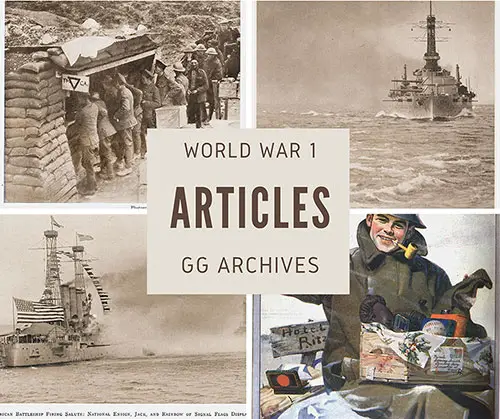
🌍 World War I - Articles on The Great War: A Deep Dive into the Global Conflict
🔍 Overview: A Comprehensive Collection on the Great War
This section of the GG Archives' World War I Collection presents a wealth of articles covering major battles, military operations, technological advancements, and personal narratives from the First World War. From the Christmas Truce of 1914 to the Sinking of the RMS Laconia and the role of immigrant soldiers, these articles shed light on often-overlooked aspects of the conflict while providing valuable primary sources for teachers, students, historians, and genealogists.
As the 1914–1918 conflict came to be known, the Great War became a world war indeed as it drew in Japan, British colonies in the Pacific, and European colonial holdings throughout Africa, Asia, and North America.
Meanwhile, wary of embroiling itself in the conflict, the United States initially remained neutral. It pursued international trade profits while protecting its interests at home and in the Pacific.
World War I raged around the globe for almost three years before the United States officially entered the fight on 6 April 1917. The fighting ended after the Armistice on 11 November 1918.
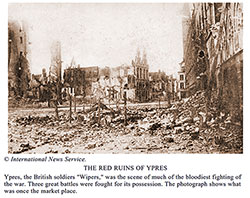
A detailed chronology of the war, month by month, dates the minor and major events of the First World War; in chronological order, important events are briefly described providing a succinct birdseye view of the Great War.
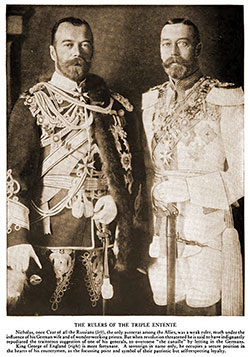
The Campaigns Against Russia 1914-1917
There was also fighting on a vast scale in Eastern Europe between the Central Powers and Russia. The Russians began well with two invasions of East Prussia. Still, the Germans found a Saviour in General Hindenburg, who drove the enemy back into his territories.
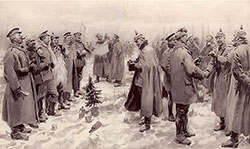
The Christmas truce was a series of widespread unofficial ceasefires along the Western Front of the First World War around Christmas 1914. The truce occurred only five months into the war.
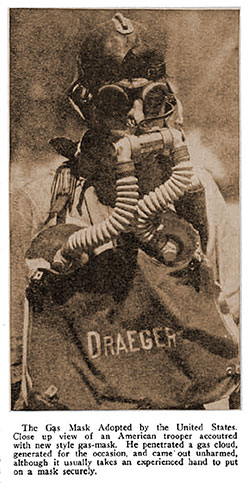
Chemical Warfare - "Gas" In This War
The direct use of poison gases, however, was inhibited explicitly by The Hague Convention. They were used deliberately on part of the Ypres salient for the first time on April 22, 1915.
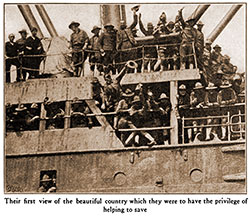
Arrival of American Expeditionary Force Divisions
Descriptions of various American Expeditionary Force Divisions that Arrived in France During 1918: Five divisions arrived in July 1918, Five during August, and another five during September for a total force of 15 divisions.
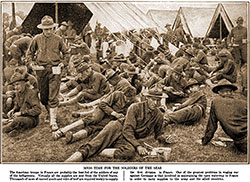
Feeding the Men on the Front Lines During World War I
The troops, having to march many miles a day, would greatly suffer if always compelled to await the arrival of the train carrying food. Therefore troops in the field must carry rations with them, and the ration consumed during the day must be replaced by the train at night.
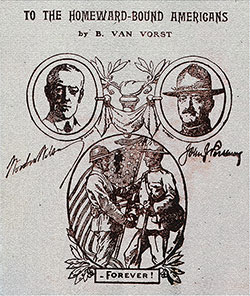
Americans Arrive in Paris - Homeward Bound Americans
So, in June 1917, when General Pershing arrived in Paris with the first contingent of the Expeditionary Forces, there were crowds in the streets and about the station to meet him and to acclaim the American soldiers.
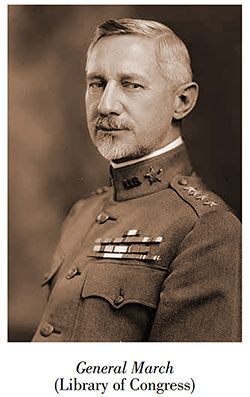
Chronology of WW1 American Operations
General March, American Chief of Staff, appended the following chronology to his annual report to Secretary Baker, made public on December 5, 1918. It is a complete official summary of the chief operations of the United States Army in France.
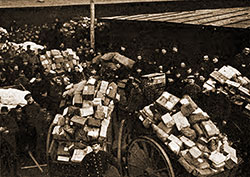
Food Supplies Forwarded to German Prison Camp For Captured American Soldiers
Captured American soldiers arrived in German prison camps, and American Red Cross emergency food parcels were awaiting them if arrangements already in operation were entirely carried out.
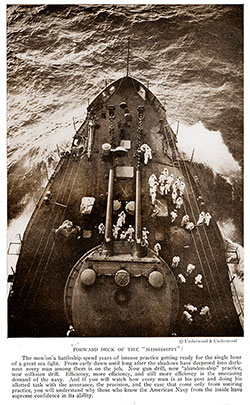
The Gem of the Ocean - Our American Navy
Offensive methods, daring attacks, maneuvering to obtain the advantage, and shooting quickly and hitting the enemy vessel are the essentials of high command afloat.
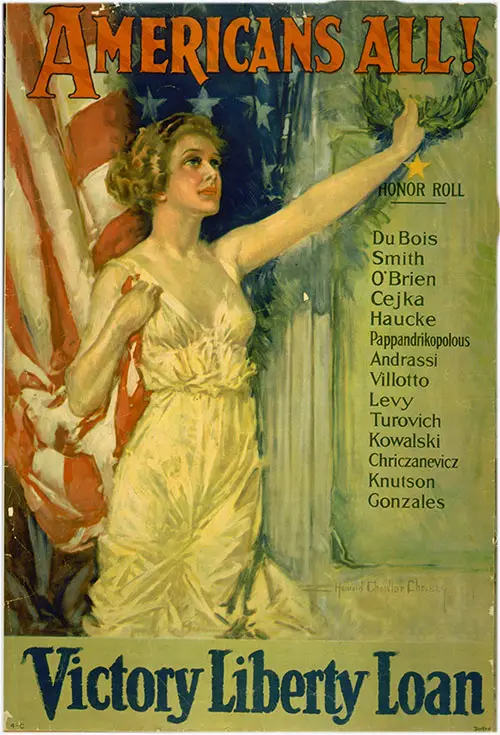
🪖 The Immigrant Army: How Foreign-Born Soldiers Helped Win World War I
📜 A Forgotten Chapter in American Military History
During World War I, immigrants played a crucial role in the U.S. armed forces, making up over 18% of the military. This page sheds light on their service, challenges, and sacrifices, offering teachers, students, genealogists, and historians a unique perspective on how these foreign-born soldiers helped shape the war effort.
With millions of new immigrants arriving in the U.S. between 1901 and 1920, America entered the war at the height of mass migration. These immigrants sought to prove their loyalty, gain U.S. citizenship, and serve the country they now called home. From learning English in military training camps to earning the Medal of Honor, immigrant soldiers played a pivotal role in the war and its aftermath.
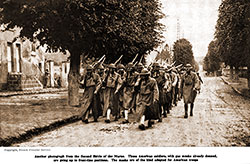
In The Battles of the Great War
With clear foresight, General Pershing insisted on developing a "self-reliant infantry, thoroughly drilled in the use of the rifle and the tactics of open warfare."
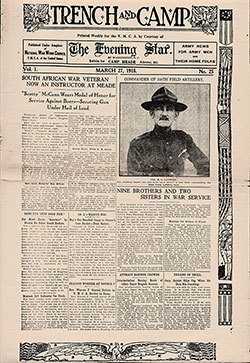
A National War Service Newspaper
During the summer of 1917, it occurred to a number of those interested in the war work of the Y M C A that a national newspaper published primarily for and so far as possible by the service members would meet this need.
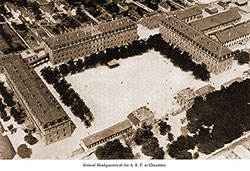
Personnel of the AEF in France
Listing of the United States Armies, Commanders, Divisions, Brigades, Regiments, and Battalions that served in France during the Great War, 1917-1918.
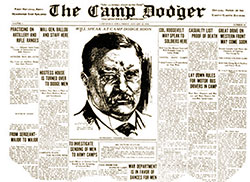
Review of Camp Dodger and The Bayonet Camp Newspapers
The first newspaper in the National Army, The Camp Dodger, the official publication of the Eighty-Eighth Division, U.S.N.A., was published at Camp Dodge. Iowa is a four-page eight-column sheet of vital interests.
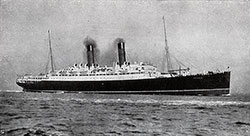
RMS Laconia Torpedoed by German U-Boat
Realizing that we had been torpedoed, my imagination was somewhat disappointed at the slightness of the shock and the meekness of the report. One or two chairs tipped over, a few glasses crashed from table to floor, and instantly, every man in the room was on his feet.
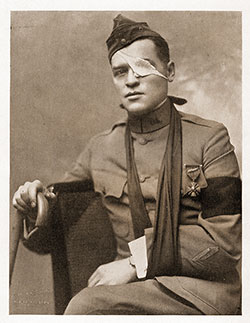
Sinking of the Cunard "Laconia"
The Cunard Line RMS Laconia, launched in 1912, was a beautiful ship that became a fatality of the first world war when she was torpedoed and sunk on 25 February 1917 by the German submarine SM U-50. This article is a first-hand account of Chicago Tribune reporter Floyd Gibbons, who became a war correspondent.
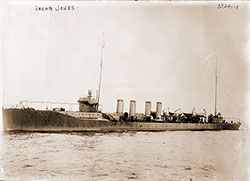
The Sinking of the American Destroyer Jacob Jones
The American destroyer Jacob Jones, one of its class's largest and fleetest vessels, was torpedoed and sunk by a German submarine on December 6, 1917 while on patrol duty in North Atlantic waters.
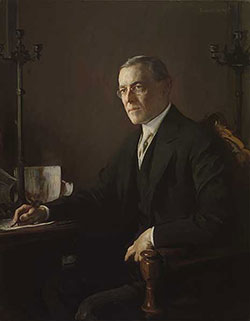
The American People and The Great War
The effect of the war on the United States will depend upon what American citizens say and do. Every man who loves America will act and speak in the true spirit of neutrality, which is the spirit of impartiality and fairness, and friendliness to all concerned.
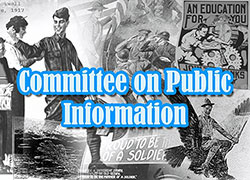
The Committee on Public Information has modified its press regulations. It has issued the following rules that are now presented to the publishers of America to protect our military and naval forces and merchant shipping.
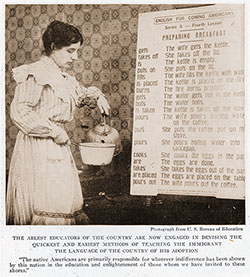
What Does It Mean to Be an American?
What is it to be American? We say that it is to love the Stars and Stripes. But a flag is no more than a symbol. It represents hopes and fears, struggles and achievements. Something is done and yet to be done.
📌 Who is this collection for?
✔ Teachers & Students – A rich compilation of key events, battles, and firsthand accounts perfect for history lessons and research.
✔ Historians & Researchers – Offers detailed military and political insights into how World War I unfolded across different theaters.
✔ Genealogists & Family Historians – Provides military records, ship lists, and newspaper archives to help trace ancestors who fought or were affected by the war.
🌟 This collection is a must-read for anyone interested in the causes, consequences, and personal stories of World War I!
📜 Key Highlights from the Collection
🕰️ WW1 Timeline (1914-1918): A Month-by-Month Breakdown
✔ A detailed chronology of major and minor events of World War I.
✔ Helps readers visualize the war's progression and key turning points.
✔ Essential for students, teachers, and military historians studying battle strategies and war policies.
🔹 Why This Matters:
🔹 Provides a structured overview of the war for easy reference.
🔹 Helps track major developments, from the first shots fired to the signing of the Armistice.
⚔️ The Eastern Front: Campaigns Against Russia (1914-1917)
✔ Germany and Austria-Hungary fought Russia on the vast Eastern Front.
✔ General Hindenburg’s victories in East Prussia shifted the war's momentum.
✔ Russian defeats contributed to the 1917 Russian Revolution.
🔹 Why This Matters:
🔹 Most people focus on the Western Front, but this article highlights the massive battles in Eastern Europe.
🔹 Shows how Russia's struggles led to its withdrawal from the war and the Treaty of Brest-Litovsk.
🎄 The Christmas Truce of 1914: A Moment of Humanity Amidst War
✔ One of the most famous moments of World War I – spontaneous ceasefires along the Western Front.
✔ British and German soldiers sang carols, exchanged gifts, and even played football in No Man’s Land.
✔ Did not last long, but became a symbol of peace and fraternity.
🔹 Why This Matters:
🔹 An extraordinary example of human connection even in wartime.
🔹 Provides teachers with a great discussion point about the moral complexities of war.
☠️ Chemical Warfare – The Rise of Poison Gas in WWI
✔ Germany first used chlorine gas at Ypres in 1915, violating the Hague Conventions.
✔ Led to the development of gas masks, mustard gas, and new battlefield tactics.
✔ A major innovation that changed modern warfare forever.
🔹 Why This Matters:
🔹 Essential for understanding the horrors of trench warfare.
🔹 Reveals how chemical weapons became a lasting threat in future conflicts.
🇺🇸 Arrival of American Expeditionary Force Divisions (1918)
✔ The U.S. entered the war in 1917, but large-scale troops arrived in 1918.
✔ 15 U.S. divisions deployed in France between July and September.
✔ American forces played a key role in the final offensives that ended the war.
🔹 Why This Matters:
🔹 Shows how the U.S. transformed the war in its final stages.
🔹 Genealogists can trace ancestors who served in these divisions.
🥖 Feeding the Troops: How Soldiers Were Nourished on the Front Lines
✔ Soldiers had to carry their own rations since food deliveries weren’t always possible.
✔ Military diets were basic, consisting of bread, canned meats, and biscuits.
✔ The logistics of feeding millions of troops was an enormous challenge.
🔹 Why This Matters:
🔹 Great for students learning about daily life in the trenches.
🔹 Explores the struggles of military supply chains and wartime logistics.
🪖 The Immigrant Army: How Foreign-Born Soldiers Helped Win World War I
✔ Over 18% of U.S. troops were immigrants, many seeking citizenship.
✔ Immigrants fought bravely and earned Medals of Honor.
✔ Training camps included English lessons to help non-English speakers.
🔹 Why This Matters:
🔹 A forgotten chapter of American military history.
🔹 Ideal for discussions on immigration, loyalty, and national identity.
🚢 The Sinking of RMS Laconia & USS Jacob Jones: America’s War at Sea
✔ RMS Laconia was torpedoed by a German U-boat in February 1917, killing Americans.
✔ The attack pushed the U.S. closer to declaring war.
✔ The USS Jacob Jones, an American destroyer, was also sunk by a U-boat in 1917.
🔹 Why This Matters:
🔹 Reveals how unrestricted submarine warfare forced the U.S. into the war.
🔹 An important event in naval history and the evolution of anti-submarine warfare.
📰 Trench and Camp Newspapers: The Role of Journalism in WWI
✔ Newspapers like The Camp Dodger and The Bayonet kept troops informed and entertained.
✔ Covered battlefield stories, home front news, and morale-boosting articles.
✔ A fascinating look at wartime media and its role in shaping public perception.
🔹 Why This Matters:
🔹 Shows how soldiers stayed connected to the world outside the trenches.
🔹 Great resource for media studies and journalism students.
🔍 Final Thoughts: A Must-Explore Collection for WWI Enthusiasts
📌 For educators, these articles offer compelling narratives and primary sources to enhance classroom discussions.
📌 For historians, the collection provides detailed military records, personal accounts, and insights into lesser-known aspects of the war.
📌 For genealogists, these stories help reconstruct family histories and trace the experiences of soldiers who served.
🌟 From the trenches of the Western Front to the sinking of warships and the role of immigrant soldiers, this collection captures the depth and complexity of World War I like never before. 🇺🇸🪖📜
